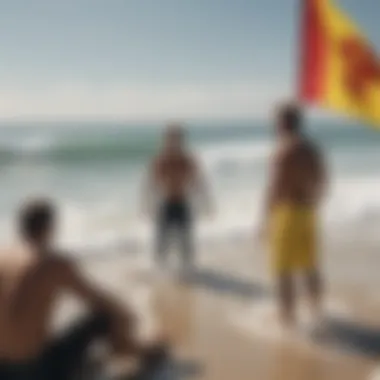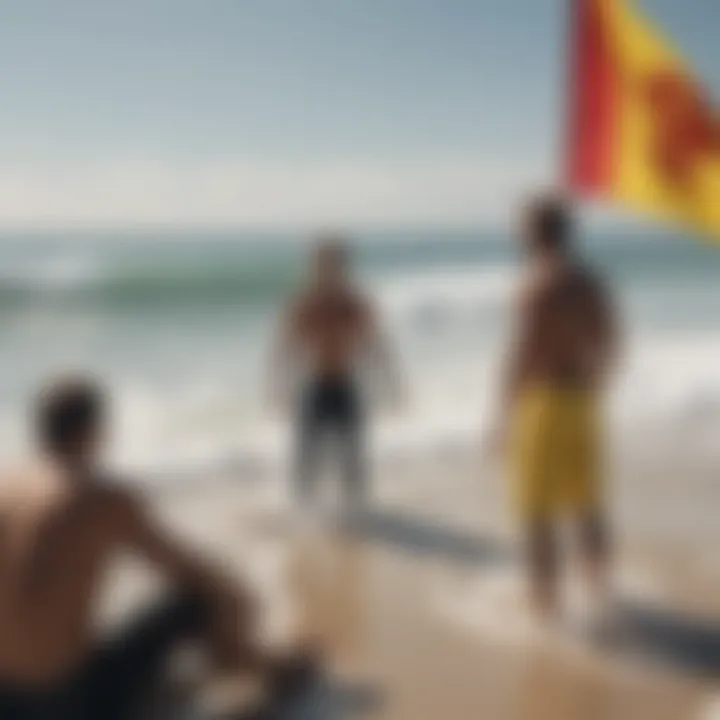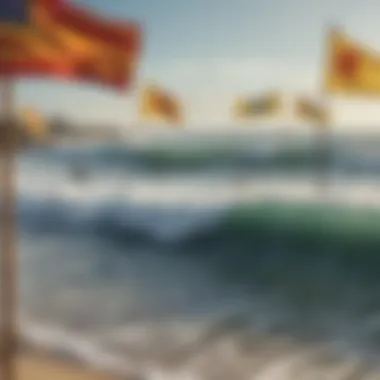Understanding Red and Yellow Flags in Surfing Safety


Intro
Surfing is more than just catching waves; it’s about being aware and adapting to conditions that can change in the blink of an eye. Red and yellow flags serve as crucial indicators of what to expect when you hit the water. Understanding these flags is essential for not only personal safety but also for the overall well-being of the surf community.
The ocean is powerful, and it doesn't take much for conditions to shift from fun and manageable to dangerous. This section lays the groundwork for understanding the implications of these flags, focusing on their meanings and the actions surfers should take in response. By staying informed about what these colors signify, surfers of all skill levels can enjoy their time on the waves while keeping safety paramount.
Surfboarding Techniques
A solid grasp of surfing techniques helps surfers navigate the water more effectively—especially when conditions are marked by flag warnings. Understanding how to adjust one’s approach based on warnings can make the difference between a thrilling experience and a risky one.
Beginner Tips for Mastering the Basics
For those just starting, focusing on the fundamentals can’t be overstated. Here are a few key tips:
- Assess the Conditions: Always take a moment to observe the waves, currents, and flag signals before hitting the water.
- Practice Balance: Spend time on land working on balance to ease your transition into surfing.
- Learn to Fall: Knowing how to fall safely can prevent injury when you inevitably wipe out.
- Start Small: Begin with smaller waves to build confidence before tackling bigger ones.
Advanced Techniques for Seasoned Surfers
Experienced surfers can build on basics with more complex maneuvers and insights:
- Reading the Ocean: Identify patterns in the waves and currents. Recognizing how these elements interact can enhance your ride.
- Tactical Positioning: Adjust your position according to the surf conditions. Move out of the impact zone if the flags indicate rough waters.
- Communication: Engage with fellow surfers about conditions; sharing tips and insights can foster a safer environment.
"Being aware of your surroundings is as important as mastering the art of paddling out."
Surfboard Equipment
Choosing the right surfboard and gear is essential for maximizing both enjoyment and safety on the water. Flags cannot prevent accidents; however, the right equipment can help you better manage the surprises that the ocean throws your way.
Essential Gear for Every Surfboarder
A well-rounded surf kit can make all the difference:
- The Right Board: Opt for a board suitable for your skill level and the wave conditions.
- Leash: A reliable leash keeps your board close, especially during turbulent times.
- Wetsuit: Depending on the weather, a suitable wetsuit can keep you warm and comfortable.
- Sun Protection: Don’t forget sunscreen. You can spend hours outside, and UV exposure can build up.
The focus needs to extend beyond equipment, tying in closely with the awareness of flagged warnings. Knowing how the equipment interacts with ocean conditions can significantly affect your experience.
While mastering techniques and selecting the right gear are vital, the heart of safety in surfing truly lies in understanding the implications of those red and yellow flags. This article will continue to delve into what those colors mean, how best to read the ocean, and the importance of vigilance for all who venture into its waters.
Preamble to Surf Safety
When it comes to combing waves and enjoying the surf, understanding safety measures can’t be glossed over. Surf safety is about more than just having the right gear; it’s about recognizing the elements present in the ocean and making sound decisions to keep oneself—and others—safe. The complexities of the surf environment can be both exhilarating and daunting. In this article, we dig into the critical aspects of surf safety, emphasizing the roles that red and yellow flags play in warning surfers about ocean conditions.
The Role of Flags in Surfing
Flags are not just colorful pieces of fabric fluttering in the breeze; they are warnings. The red and yellow flags hold significant meanings and can alternately signal both danger and caution. The red flag, for instance, serves as a stark alert that surfers need to reassess their surroundings. It indicates strong currents and potential hazards lurking beneath the surface. On the other hand, the yellow flag acts as a call to vigilance but suggests that it’s generally safe to surf—albeit with some precaution.
These flags are valuable tools for ensuring safety at surf spots. By understanding what each flag means, surfers can better gauge whether they should hit the water or wait it out for a better day. Moreover, these visual signals often come with local knowledge that can save lives.
Why Awareness is Key
Awareness in surfing is not just a nice-to-have; it’s a survival skill. The ocean is a living entity that is continuously changing due to weather, tides, and tides. Ignoring the flags can be the difference between a thrilling experience and a perilous situation. Every surfer needs to adopt a proactive stance in understanding the implications of the flags.
- Stay informed: Knowledge about surf conditions changes from one day to the next. Check local surf reports, and don't hesitate to ask lifeguards about conditions.
- Observe fellow surfers: If more experienced surfers are cautious, take note. Their instinct is often built on years of practice. You could learn a thing or two.
- Trust your gut: If something doesn’t feel right—maybe the waves look too big, or the flags are signaling caution—there's often a reason. It’s wisest to heed that instinct.
"A wise surfer knows when to paddle in and when to catch a wave."
The ability to truly see what's happening in the water allows surfers to make informed decisions. In a sport that thrives on adventure, awareness acts as the net that catches would-be accidents before they escalate into real danger.
Overview of Flag Colors
Understanding the flags in surfing is essential for ensuring a safe experience in the water. The primary colors of the flags—red and yellow—serve as warnings, providing vital information about the conditions of the ocean and the surf. Each color carries a specific meaning, which cannot be overstated in its importance for surfers of all skill levels. In this section, we will delve into the significance of the red and yellow flags, exploring their characteristics and the implications they carry for those looking to enjoy the waves.
Significance of the Red Flag
Indicating Strong Currents
One primary role of a red flag is to signal strong currents in the water. These currents can be deceptive, and they typically arise from various factors such as tidal changes or underwater topography. When a red flag is flying, it indicates that the water conditions are unsafe for surfing. This is crucial for safety, as strong currents can quickly lead beginners and even experienced surfers into dangerous situations. Their swift movement could drag surfers farther from shore, making it difficult to return safely. The strong current indicator is obviously a beneficial feature in maintaining awareness and caution among surfers.
Danger to Surfers
Another significant aspect of the red flag is that it directly warns about the potential dangers present in the water. This isn't limited just to currents; it also encompasses other hazardous situations like rip tides and unsteady wave conditions. When surfers see a red flag, it should immediately prompt them to reconsider their plans for entering the water. The danger warning serves as a psychological barrier against impulsive decisions and encourages a culture of respect for nature’s unpredictability. Recognizing this as a key warning can dramatically reduce the number of accidents and injuries each year.
Emergency Situations
Red flags can also signify emergency situations. When lifeguards spot a distress signal or an unusual incident, they might raise the red flag to avert potential chaos. This reminder acts as a collective call to action, urging surfers to exit the water, heed instructions, or assist others if needed. The emergency indication feature can unite the surfing community in times of crisis, showcasing the necessity of vigilance and readiness. While emergencies can be unpredictable, understanding the implications of a red flag allows surfers to act quickly, potentially saving lives.
Meaning of the Yellow Flag


Moderate Risks
The yellow flag warns surfers of moderate risks in the water. This might include varying wave heights or minor currents that aren't necessarily dangerous but warrant caution. It's essential for surfers to recognize that a yellow flag doesn't indicate a no-go zone but rather a need for heightened awareness. This context allows surfers to still enjoy the waves while remaining mindful of potential pitfalls, making accessibility a key feature in the yellow flag's approach to surf safety.
Awareness of Conditions
When the yellow flag is displayed, it prompts surfers to be aware of current conditions in their environment. This awareness is particularly crucial in regions where weather can change quickly or where local wildlife might pose a threat. Knowing that conditions might shift even slightly can aid surfers in making well-informed decisions about their activities in the ocean. Understanding the context of awareness serves as a reminder that surfers are in charge of their safety while also recognizing that the ocean is ever-changing.
Guidelines for Surfers
Yellow flags are often accompanied by specific guidelines for surfers, explaining what to expect while surfing under these cautionary conditions. These could include recommendations such as not venturing too far from shore or keeping an eye on fellow surfers as they navigate the waves. Such guidelines assist in building a culture of camaraderie en pion like a safety net amongst surfers. They function as a bridge between knowledge and practical action, empowering surfers to make educated choices while enjoying their sport.
In summary, understanding the colors and their meanings is a critical part of surf safety. The red flag acts as a warning for strong currents, danger to surfers, and emergency situations, while the yellow flag highlights moderate risks, awareness of conditions, and important guidelines to surf responsibly.
With this knowledge, surfers can make safer choices, enhancing their experience in the water while also promoting community safety.
Conditions Indicated by Flags
Understanding the conditions indicated by flags is essential for surfers who aim to enjoy their experience while remaining safe in the ocean. The presence of flags serves as a quick reference to the prevailing conditions, alerting surfers to potential hazards that may not be apparent at first glance. By grasping the meaning behind these flags, surfers can make informed decisions and adapt their surfing tactics accordingly, ultimately leading to a safer and more enjoyable outing.
Understanding Ocean Currents
Ocean currents are crucial elements that every surfer must consider before hitting the waves. Currents can shift dramatically from one day to another, influenced by various factors such as tides, wind, and weather patterns. Understanding these currents can significantly impact your safety and skill during a surf session.
Types of Currents
Different types of currents exist in the ocean, each impacting surfing conditions in distinct ways. The most prevalent ones include:
- Longshore currents: These travel parallel to the shore and can carry surfboards along the beach. While they are often manageable, they can lead novice surfers into deeper waters if not monitored carefully.
- Rip currents: These are powerful, narrow channels of fast-moving water that flow away from the shore. They pose a higher risk for surfers, mainly when swimmers panic or do not understand how to escape.
The key characteristic of these currents is that they can change in strength at any moment. For surfers, knowing the prevailing current can make a world of difference, enhancing their ability to navigate both safely and effectively.
How Currents Affect Surf Conditions
Currents play a vital role in shaping the surf conditions for the day. Depending on the intensity and direction, they can contribute to either clean, rideable waves or choppy, messy seas that are difficult to manage. The relationship between currents and wave production can determine the quality of the surfing experience.
For example, a strong current might spread out waves, leading to poor net conditions for surfing. While riding waves in such scenarios may be exhilarating, it also introduces challenges in maintaining control and speed. Understanding how currents interact with waves allows surfers to make decisions that enhance their overall safety and enjoyment.
Wave Height and Type
Wave height and type are critical factors that directly influence the surfing experience. Each type of wave possesses unique characteristics that can either enhance or diminish the enjoyment of the ride. Thus, being aware of these variances equips surfers with the knowledge they need to navigate different water conditions.
Impact on Surfing Experience
When it comes to surfing, the height and composition of waves are everything. High waves often translate into thrilling rides, but they also require a greater skill set to manage. Conversely, smaller waves are typically better for beginners or those looking for a more laid-back session.
The nuances of wave type played an important role in determining the direction of a surfboard and overall maneuverability. Familiarity with your own capability as well as the wave type can transform potential challenges into marvelous triumphs out in the water.
Safety Concerns with Varied Waves
Every surfer encounters different wave types, each posing its own set of safety concerns. For instance, steep waves could lead to wipeouts, causing injury if a surfer is not experienced enough. Conversely, lackluster waves may trigger boredom, leading surfers to take unnecessary risks in search of a thrill.
Being aware of the dangers presented by different waves is pivotal in assessing safety. The unique challenges posed by varying surf conditions highlight the necessity of making informed decisions before paddling out. Always keeping an eye on wave patterns and breaking techniques aids surfers in safeguarding their well-being.
Navigating Surf Conditions Safely
Surfing isn't just about the thrill of riding waves; it's also about keeping yourself safe amidst the ocean's unpredictable nature. Understanding how to navigate surf conditions effectively can mean the difference between a day filled with enjoyment and one of danger. When surfers are equipped with knowledge about local warnings and their own abilities, they can make informed choices that dramatically improve safety. This section dives into key aspects surrounding safety while surfing, focusing specifically on understanding local warnings and the techniques that contribute to a secure surf experience.
Interpreting Local Warnings
Understanding Specific Warnings
It’s crucial to grasp the nuances of specific warnings when diving into the surf. These indications often come from lifeguards and local fisheries, alerting surfers to imminent dangers like rip currents, strong winds, or sudden ocean floor shifts. The key characteristic of these warnings is their direct relevance to current conditions, which is highly beneficial as it helps prevent accidents. For instance, a red flag flapping wildly can signify high surf and strong currents, making it clear that surfers should stay out of the water. A well-informed surfer is much more prepared for adventure.
One unique feature of understanding these warnings is the ability to rely on local knowledge. Many areas have standard signs or word-of-mouth updates that can alert surfers to an evolving situation. Although these warnings can sometimes be overlooked or misunderstood, successful navigation of surf conditions significantly hinges on awareness of these alerts. They are absolutely practical tools in making the ocean a safer place.
Community Guidelines
Community guidelines play a pivotal role in enhancing safety at surf spots. These guidelines are established to create a culture of respect and cooperation, ensuring that everyone in the water is aware of the general rules and dangers that may arise. The key element here is participation; local surfers usually share valuable insights about the area that contribute to a collective sense of safety. By following these guidelines, novice surfers are less likely to find themselves in harm's way.
An interesting aspect of these community guidelines is their adaptability based on seasonal changes or specific events. For instance, during surf competitions, there may be extra provisions or altered rules to enhance both competitor and spectator safety. This adaptability is crucial since surf conditions can change like the flip of a switch. By adhering to these community guidelines, surfers foster a safer environment while discovering lasting camaraderie amongst fellow enthusiasts.
Techniques for Safe Surfing
Assessing Your Skill Level
Before hopping on a board, evaluating your skill level is essential. It’s more than just knowing how to stand and paddle; it’s about recognizing the type of waves suited to your ability. The primary benefit of assessing skill is ensuring that a surfer opts for waves in alignment with their experience, avoiding dangerous situations that could lead to injury. An advanced surfer can take on powerful swells, while a beginner should look for mellow and forgiving waves.
A unique aspect of this assessment is honesty with oneself. Many surfers may overestimate their abilities, leading them into tricky waters. Therefore, taking the time to review one’s surf history and acknowledging one’s current limits creates a safer surfing experience. We all need to adopt a mindset that values prudence over bravado, especially in a realm where the ocean is ever-changing.


Choosing Appropriate Surf Spots
Selecting the right surf spot is vital for any surfer’s safety. This choice should depend on several factors: individual skill levels, current conditions, crowd size, and even environmental factors such as marine life prevalence. This selection process acts as a guide, steering surfers toward locations where they can feel confident and secure.
One unique feature of this technique is utilizing not just online resources but also the knowledge of locals. When surfers share information about spots that are currently safer or offer better conditions, it can significantly shape decision-making. The advantages, in this case, are clear; informed surfers experience fewer accidents and spend more time enjoying the waves rather than finding themselves in perilous situations.
"Preparation is key to safety in any surfing journey; knowing the waves, weather, and your skills translates to a successful day on the water."
In essence, navigating surf conditions safely involves a combination of interpretation, community engagement, and self-assessment. By honing these techniques, surfers can better enjoy the thrilling experience that comes with the waves, all while prioritizing a culture of safety.
The Community's Role in Safety Awareness
In the world of surfing, the sea can be as unpredictable as it is beautiful. Therefore, community plays a central role in fostering a culture of safety and awareness among surfers. It is not just about each surfer keeping an eye out for themselves, but rather a collaborative effort that can enhance the overall surfing experience and minimize risks. The community’s active involvement in educating and supporting each other serves multiple benefits, reinforcing the importance of vigilance among surfers and ultimately leading to safer ocean environments.
Educating New Surfers
Mentorship Programs
Mentorship programs are an essential way to bridge the gap between experienced surfers and newcomers entering the waters. In many coastal towns, seasoned surfers take it upon themselves to guide novices through the basics of surfing, from understanding the dynamics of waves to recognizing flags and their implications. The key characteristic of these programs is their personalized approach. New surfers get hands-on guidance that can't be replicated through books or online videos.
One unique feature of mentorship programs is their informal and friendly nature, creating an accessible environment for new surfers to ask questions without fear of being judged. This camaraderie fosters a sense of community, which is invaluable. However, it’s worth noting that the success of such programs largely depends on finding committed mentors who are willing to dedicate their time and expertise.
Workshops on Safety
Workshops on safety serve as formal gatherings where surfers can learn essential skills and safety measures. Typically organized by local surfing clubs or lifeguard stations, these workshops focus on the nuances of recognizing flag warnings, navigating different wave conditions, and understanding the local surf culture. A beneficial aspect of these workshops is that they bring people together, enhancing relationships among surfers, regardless of skill levels.
The unique feature here is that participants have the opportunity to engage in hands-on activities, making the learning process more effective. However, one downside may be that time constraints and scheduling conflicts can sometimes limit participation, preventing crucial knowledge from reaching all potential surfers.
Importance of Engaging with Lifeguards
Lifeguard Training and Responsibilities
Lifeguards are the unsung heroes of the beaches, dedicated to ensuring the safety of all watergoers. Their training is rigorous, covering not only rescue techniques but also beach conditions and flag systems. The key characteristic of their responsibilities is that they are often the first line of defense. Engaging with lifeguards to understand their role can significantly raise awareness about what each flag symbolizes.
A unique aspect of lifeguard training is that it includes real-time scenario simulations, preparing them for potential emergencies. When surfers understand the extent of lifeguard training, it can foster a greater sense of trust and reliance on these trained professionals. However, there can be a perception that some lifeguards are lax, which sometimes discourages surfers from seeking their guidance, a misconception that needs addressing.
Building Trust in the Community
Establishing trust within the community is paramount for effective safety management in surfing. This trust is built through consistent communication and mutual respect. Lifeguards who engage with surfers, perhaps through community events or safety demonstrations, can help develop a reliable rapport. The key characteristic here is open dialogue, which promotes a sense of partnership in safety.
One unique feature of building trust is how it encourages surfers to take shared responsibility rather than viewing safety as solely a lifeguard’s job. The downside is that misunderstandings can arise, leading to conflicts or reduced cooperation. It’s essential for both lifeguards and surfers to create a shared mission aimed at fostering a safe surfing environment.
The relationship between surfers and the community is a two-way street, where mutual respect breeds a culture of safety.
Case Studies of Flag Alerts
When it comes to surf safety, understanding flag alerts can be the difference between a thrilling ride and a perilous situation. Case studies of flag alerts provide real-life examples that highlight the importance of adhering to surf warnings. These scenarios demonstrate what can happen when surfers ignore these signals and how communities can come together to promote safety. Addressing this topic reinforces the urgency of recognizing flag meanings and implementing precautionary measures.
Incidents Linked to Ignoring Flags
Learning from Mistakes
One significant aspect of learning from mistakes involves analyzing specific incidents where surfers have disregarded flag alerts. Take, for instance, a tragic event at a popular beach spot where a group underestimated the power of strong currents indicated by a red flag. They ventured out, buoyed by excitement rather than caution. The aftermath was sobering: rescue efforts met with intense conditions that could have been avoided. This example encapsulates not just the immediate dangers but also highlights a vital lesson: awareness is paramount. Learning from such mistakes underscores the need for future surfers to respect warning flags. The unique feature of this concept lies in its dual role as both a cautionary tale and an educational tool—encouraging responsible behavior by sharing narratives loaded with real consequences.
Consequences of Disregard
The consequences of disregard for flag alerts can extend beyond individual misfortunes to community-wide impacts. A notable example involved multiple surfers heading out during a yellow flag alert, signifying moderate risk. Although no injuries occurred, the local lifeguards faced considerable challenges in managing the increased number of people in the water. This situation showcased how underestimating warnings could translate to a strain on emergency services and potential dangers for all in the area. The key characteristic of this issue is its ripple effect; disregarding flags doesn’t just risk personal safety but could endanger others as well. Understanding these consequences helps to reinforce the necessity of adhering to the guidelines set by experienced lifeguards, contributing to overall safety at the beach.
Successful Responses to Flag Alerts
Positive Community Actions
Positive community actions represent a crucial aspect of effective responses to flag alerts. For instance, certain beach neighborhoods have initiated educational campaigns that inform surfers about the meaning of flags and the critical response strategies in emergencies. By advocating for flag awareness and providing training sessions on surf safety, communities have made substantial strides in reducing incidents linked to oversight of flags. These initiatives highlight that taking a proactive stance can foster better relations between surfers and lifeguards, improving overall safety in shared spaces. A unique trait of these community actions is their grassroots nature, bringing together locals who share a common passion for surfing and safety.
Translating Awareness into Prevention
Translating awareness into prevention signifies the act of transforming knowledge about flag conditions into actionable steps for avoiding risks. One way communities achieve this is through interactive workshops that teach surfers how to assess conditions and read flags accurately. For example, in some areas, community leaders work with schools to integrate surfing safety into gym classes, creating a culture of awareness from an early age. This approach has proven beneficial, as children grow into informed surfers, shaping the future of coastal safety. Importantly, the unique feature of this method lies in its preventative potential, showcasing that informed decision-making foundations can lead to safer practices down the line.
The path to surf safety begins with understanding flag signals. Educating ourselves and others fosters a responsible surf culture that values awareness over recklessness.
By turning real-world incidents into learning tools and taking proactive community measures, surfers become empowered to prioritize safety. Through understanding both the dire consequences tied to neglecting flag meanings and the positive community efforts in response, the surf culture can evolve into a more responsible and safety-conscious environment for everyone involved.
Integrating Technology in Surf Safety
In today’s digital age, surf safety is increasingly intertwined with technology. As surfers face unpredictable ocean conditions, having tools that provide immediate information can be a game-changer. From apps that send real-time updates on surf conditions to platforms fostering community feedback, the integration of tech in surfing is a necessity rather than a luxury. Such innovations not only enhance safety measures but also empower surfers with knowledge at their fingertips.
Apps and Modern Tools
Real-time Updates


Real-time updates have opened up new avenues for surfers to stay informed. These tools track changing conditions, guiding surfers towards safer experiences. The key characteristic? Instantaneous data delivery that keeps users in the loop about hazards like rip currents or sudden weather changes. This dynamic responsiveness makes real-time updates a beneficial choice for any surfer looking to ride waves while minimizing risks. One unique feature is the live surf condition maps, allowing users to visually assess conditions before heading out. While empowering, it’s essential to stay aware of potential inaccuracies in location-based reporting, as cellular service might be spotty in certain areas.
Community Feedback Platforms
Community feedback platforms provide a vital avenue for peer-supported information sharing. Users can report conditions and experiences which form a collective knowledge base that adds depth to the data provided by apps. The main characteristic of these platforms is their interactive nature, which directly involves the surf community in the decision-making process. This aspect makes these platforms particularly appealing as they encourage a sense of belonging while enhancing safety through shared knowledge. One unique feature includes live chat options where surfers can ask questions and receive immediate feedback from other users. A downside might be the potential for misinformation if platforms aren’t moderated effectively, which highlights the need for responsible reporting among community members.
Innovative Solutions for Hazard Awareness
Safety Alerts via Notifications
Safety alerts through notifications serve as a lifeline for surfers. These alerts, when subscribed to, offer timely warnings about changing surf conditions, ensuring that surfers do not head into perilous waters. The key characteristic here is immediacy; alerts are communicated as soon as danger is detected. This makes them a popular choice for many surfers who prioritize safety. Moreover, a helpful feature of safety alerts is their customizable settings—surfers can tailor notifications based on specific risks in their preferred locations, allowing for a personalized safety net. However, there can be a drawback; if users ignore alerts over time, they might dismiss genuine warnings, leading to dangerous situations.
Informed Decision-Making Tools
Informed decision-making tools utilize data analytics to empower surfers to make educated choices about where and when to surf. This involves integrating various datasets, such as weather forecasts and tide patterns, to paint a complete picture of the surfing environment. The key characteristic of these tools is their comprehensive approach, combining multiple sources of information that surfers can trust while planning their sessions. Features like algorithm-generated recommendations based on user preferences enhance usability. That said, it’s crucial to recognize that technology cannot replace personal judgement; over-reliance on such tools might lead to complacency among surfers regarding their situational awareness and instinctive decision-making.
"Embracing technology in surf safety isn't just about having the right gadgets; it's about augmenting one’s instincts with informed, real-time guidance to foster a safer surfing community."
As technology continues to evolve, so too does its potential impact on surf safety and awareness. By integrating these innovative tools into their routines, surfers can significantly enhance their experience—hopefully making it as thrilling as it is secure.
Environmental Considerations
When discussing surf safety, the environmental factors play a crucial role. Understanding how various elements impact ocean conditions can significantly affect a surfer's experience and safety. The delicate balance of ocean currents, wave heights, and environmental situations isn't just a backdrop for surfing; it's the very fabric that weaves surfers’ experiences together. With growing concerns around climate change, being mindful of these conditions is more important than ever.
Effects of Climate on Ocean Conditions
Changing Weather Patterns
Climate shifts lead to changes in weather patterns, which can dramatically impact ocean conditions. For instance, a warmer ocean affects the migration of fish and changes how waves break, possibly affecting local surf spots. Storms might become more frequent or intense due to these altered patterns, influencing wave size and current strength.
The key characteristic here is the unpredictability that comes with these changing conditions. Surfers who are aware of these developments can adapt better. This awareness allows for a more informed surfing experience, lifting the importance of checking the weather before heading out.
However, while understanding changing weather patterns may be beneficial, it can also present challenges. Surfers must remain alert and ready to change plans based on sudden shifts in weather conditions that were unforeseen.
Global Warming and Surfing
Global warming is another pressing issue affecting surfing. As global temperatures rise, so do sea levels and ocean temperatures. This contributes to changes in wave patterns, which might alter the dynamics at popular surf locations. High tides influenced by global warming can mean less beach space and potentially more hazardous conditions.
The unique feature of this concept is its ripple effect on the surfing community. Surf spots that were once considered safe may become difficult or dangerous. Surfers must be proactive and attentive to these changes, which directly contributes to the overall safety and awareness discussed in this article.
Yet, while this subject brings to light significant concerns for surfers and enthusiasts, it also serves as a call to action. Educating oneself about global warming's impact can foster a stronger community. By being aware and sharing information, surfers can advocate for initiatives that protect surf conditions, which may include ocean conservation efforts.
Promoting Sustainable Surfing Practices
Eco-Friendly Surf Gear
The choice of surfing equipment plays a vital role in sustainability. Eco-friendly surf gear includes products made from recycled materials or sustainable practices. Utilizing materials that lower environmental impact can positively influence ocean health.
A standout characteristic of eco-friendly surf gear is its growing availability. Boards made from biodegradable materials or wetsuits crafted from natural rubber or recycled plastics are gaining traction in the market. This shift not only benefits the environment but also attracts environmentally conscious surfers.
One downside, however, could be the cost factor. Eco-friendly products sometimes come with a heftier price tag, which may not be appealing to every surfer. But the long-term benefits to the environment might outweigh initial costs, making it a worthy investment in the health of the sport.
Conservation Efforts
Conservation efforts are integral for a sustainable surfing future. Initiatives organized by local communities or international groups focus on preserving coastlines and marine ecosystems. This could be anything from beach clean-ups to legislative advocacy for better environmental protection.
The key characteristic of these efforts is their community-driven nature. Engaging local surfers in conservation projects fosters a sense of responsibility and stewardship towards ocean health. Surfers often share a camaraderie that can extend beyond the beach, promoting initiatives collectively.
However, some may argue that these efforts require significant time and commitment, which can be a challenge for a busy surfer lifestyle. Nevertheless, integrating these activities into the surf culture creates deeper connections to the ocean, ultimately enriching the surfing experience and raising awareness about environmental issues.
Engaging in eco-conscious practices not only shapes a surfer’s identity but also contributes to the preservation of their beloved surf spots.
In summary, being aware of environmental considerations goes hand in hand with a safe surfing experience. By staying mindful of climate impacts and promoting sustainability, surfers can help ensure that they, and future generations, continue to enjoy the swell and surf that the ocean provides.
Ends and Forward Steps
In the context of surf safety, recognizing and understanding red and yellow flags isn't just a recommendation—it's a necessity. These flags serve as visual cues that can significantly influence both individual and community safety in surfing environments. Acknowledging and acting on these warnings can mean the difference between a thrilling day on the waves and a dire situation requiring rescue.
Summarizing the Importance of Flag Awareness
Flag awareness is crucial because it encapsulates the surfer's responsibility towards themselves and others in the water. By comprehending the meanings behind these flags, surfers can make informed decisions that enhance their safety. For example, a red flag might imply treacherous conditions that even seasoned surfers should heed. Ignoring this caution can lead to accidents or drownings, reinforcing the need for ongoing vigilance.
The following points illuminate the importance of maintaining awareness of flag systems:
- Improved Safety: Awareness directly correlates with the ability to avoid danger. Understanding the implications of each flag color means surfers can stay safe while enjoying their hobby.
- Community Responsibility: When surfers act responsibly as a community, it nurtures a culture of safety. Sharing knowledge about flags with others fosters an environment where safety comes first.
- Promoting Preparedness: Familiarity with flag alerts encourages surfers to be prepared for sudden changes in conditions. This preparedness can minimize risk and enhance their overall experience.
"A wise surfer is one who knows when to catch a wave and when to stay on the beach."
Encouraging Continued Education and Community Engagement
The journey toward a safer surfing community is ongoing. It's not enough to just grasp the flag system; engagement and education must be encouraged on multiple fronts. Having regular safety workshops can bolster skills and reinforce the importance of flag awareness among newcomers and experienced surfers alike.
Additionally, building a rapport with lifeguards can substantially increase the efficacy of safety awareness. Lifeguards are often the frontline heroes in preventing accidents; by developing trust with them, surfers can better understand local conditions and flag meanings.
To move forward effectively, consider these initiatives:
- Organize Community Workshops: Gather proponents of surf safety to share best practices among surfers, ranging from flag meanings to ocean safety tips.
- Utilize Social Media Platforms: Engage with local surfing communities on platforms like Reddit or Facebook, sharing updates and solidifying a community of safety-minded surfers.
- Create Informative Content: Blogs, vlogs, and infographics regarding flag systems could spread awareness to a wider audience, addressing both surfers and potential beachgoers.
In essence, encouraging continued education and engagement ensures that the importance of flag awareness remains in the foreground. With these steps, the surfing community can focus on enjoyment while knowing they have the tools to fish for safety, not danger.















